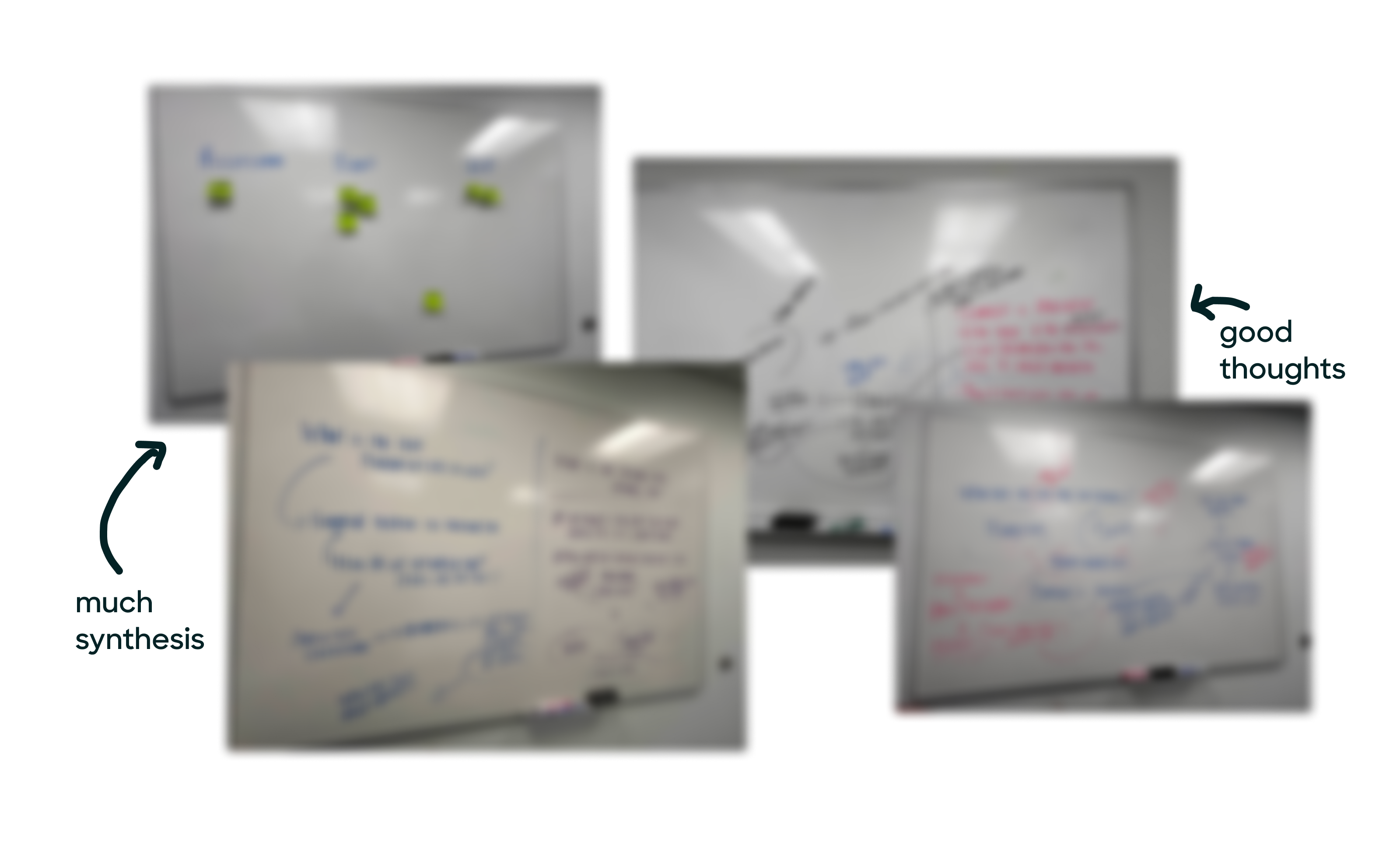This research project was conducted for Personawealth (now Calibrate), a behavioral finance technology startup focused on leveraging advanced psychological and behavioral science to improve financial well-being.
At the time of this study, the company was defining how its core behavioral framework could translate into an emotionally resonant user experience. I led a qualitative research sprint to validate early behavioral hypotheses and better understand how users perceive their own financial challenges and motivations. These insights helped clarify how behavioral data could translate into a more empathetic product experience.
✎ THE RESEARCH PROBLEM
Understanding User Psychology
At the time, the company utilized a proprietary behavioral science framework to segment users based on their attitudes, emotions, and habits around money. This segmentation allowed the platform to generate personalized guidance tailored to a user's mindset, such as their confidence level, financial avoidance, or readiness for change.
My research sprint was tasked with bridging this theoretical framework with the lived, emotional experiences of real users, with the goal of translating these findings into an actionable and empathetic product direction.
I wanted to know:

✎ RESEARCH PLANNING AND EXECUTION
The Methodology
To investigate this, I led a one-month qualitative research sprint focused on exploring our behavioral assumptions and uncovering opportunities for refinement.
Recruitment & ParticipantsWe recruited participants from the company's "established network of users" within a key target demographic. The criteria for inclusion were specific and required that participants:
- Had completed the proprietary behavioral assessment.
- Had been assigned to a behavioral segmentation.
- Had received their personalized feedback report
- Represented different behavioral segmentations to allow for cross-validation.
While the research plan aimed for a minimum of 5 participants, limitations restricted the sprint to 3 completed interviews. Despite the smaller sample size, the sessions yielded rich qualitative insights that helped support key assumptions and revealed new opportunities for refinement.
Data Collection & Key QuestionsEach 45-minute remote, semi-structured interview was designed to surface how users made sense of their financial behaviors and the feedback they received. This method was selected to provide the flexibility needed to deeply explore sensitive emotional triggers and financial habits, which would be impossible to capture in a survey.
Sessions explored participants' financial habits, emotional triggers, and reactions to their personalized assessment feedback—particularly whether the tone and descriptions felt accurate, validating, or disconnected. Participants were asked to reflect on their own financial problem statements, motivations, and behaviors, and to share how they understood and applied the insights provided in their reports.
Through this process, I aimed to understand:
✎ SYNTHESIS AND ANALYSIS
Mapping Interviews → Insight
Qualitative data from the three semi-structured interview transcripts was analyzed using thematic coding and affinity mapping to identify recurring behavioral patterns and emotional themes. Throughout the process, I synthesized raw notes, observational data, and post-session reflections into higher-level insights through iterative sensemaking and clustering

These analyses informed the final Insights Report, which consolidated validated assumptions, emergent user needs, and actionable product recommendations. The key findings below represent the most consistent patterns observed across all participants.
FINDING 1
Users perceive their financial problems as failures to complete specific tasks.
Frequency: 3/3 participantsWhen asked about their financial problems, participants consistently defined this problem as a failure to perform a "general financial task," such as not budgeting or not saving enough. Habits like "budgeting" function more as "symbolic or moral standards" rather than a practical tool. Participants believed budgeting, and other financial tasks, were something they should be doing even if none of them consistently performed those tasks. This suggests that users may carry strong internalized beliefs about what responsible financial behavior looks like, even if they struggle to enact those behaviors in practice. It's not as much about the specific task itself as it is about the emotional weight and self-judgment associated with not meeting those internal standards. Additionally, it's not as much about whether these financial tasks are effective for them, but rather how they serve as markers of personal responsibility and self-worth.
FINDING 2
Users are often highly self-aware of the internal reasons for these task failures.
Frequency: 3/3 participantsParticipants were conscious of the emotional, cognitive, or educational barriers influencing their behavior (e.g., linking lack of saving to emotional overspending in P1 or P3 acknowledging a lack of financial literacy). However, this awareness did not necessarily translate into effective behavior change.
FINDING 3
A "false sense of completion" can create a lack of urgency to change.
Frequency: 2/3 participantsParticipants often experienced a false sense of completion driven by the morally framed financial behaviors discussed in Finding 1 that signaled responsibility (e.g., having an emergency fund) rather than produced meaningful change. This moral validation created a false sense of security that actively worked against motivation for deeper habit change. This suggests that users may conflate performing certain financial actions with making real progress, leading to complacency and reduced motivation for further improvement. For example, users may feel that simply having a budget or savings account is enough, even if they are not actively managing or optimizing those tools to improve their financial health. Participant 1 contributed to a 401(k) and had some investments, which gave them the impression they were “doing enough”—even though they weren't actively planning for large known expenses and admitted that if they lost their job, they would be financially vulnerable. When users feel they are “doing enough” financially, they become less likely to take actionable steps toward more meaningful financial goals.
FINDING 4
True motivation is often only triggered by significant, external events.
Frequency: 3/3 participantsFor all participants interviewed, the motivation to change was not driven by internal anxiety, but by strong external forces (e.g., losing a job). This suggests that users may require significant external catalysts to overcome inertia and initiate meaningful financial behavior change. Internal motivations, such as personal dissatisfaction or anxiety about finances, were insufficient to drive action without a compelling external event. This indicates that some users may need more than just internal reflection or self-motivation to make lasting changes to their financial habits. Instead, they may require tangible external triggers that create a sense of urgency or necessity to act.
FINDING 5
The assessment/report's primary value is emotional resonance, not wealth of data or information.
Frequency: 3/3 participantsThe research strongly suggests that the format of the personalized behavioral feedback is not as important as the emotional validation the users get from the report itself. All participants reported that receiving personalized feedback made them feel "seen" and "understood," even if they did not fully agree with all of the insights or apply the specific recommendations. This indicates that the emotional impact of feeling validated and recognized may be more critical to user satisfaction than a specific mass of data or guidance provided. Users may prioritize the sense of connection and empathy they experience from the assessment over the practical utility of the information presented.
✎ RECOMMENDATIONS & BUSINESS IMPACT
Mapping Insights → Direction
While the sample size (N=3) limited true validation, consistent emotional patterns emerged that informed several actionable design directions. Each recommendation synthesizes insights across multiple findings, bridging user emotion, cognition, and motivation into product-level opportunities.
DIRECTION FROM FINDINGS 1, 5
How might we reframe personalized feedback around emotional resonance?
If the primary value of personalized feedback is its emotional resonance rather than its informational depth, we should focus on maximizing this resonance. Shorter, emotionally focused reports that prioritize validation can avoid the cognitive overload that leads to inaction.
DIRECTION FROM FINDINGS 1, 2, 5
Why don’t we normalize user experiences through comparative data?
Users hold strong internalized beliefs about money, and not meeting these socialized standards causes shame or isolation. We could introduce contextual, comparative data within personalized feedback to normalize behavior and reduce stigma, transforming emotional shame into productive reflection.
DIRECTION FROM FINDINGS 2, 3, 4
Could we translate behavioral insights into contextual nudges?
Participants demonstrated a strong self-awareness, they recognized the emotional or cognitive reasons behind their financial inaction but lacked the motivation or structure to act on that awareness . To tackle the user motivation problem, could we tie emotionally intelligent nudges to real time behaviors? For example, if a user makes a high-emotion purchase could we develop a system that prompts reflection or offers insight? These contextual micro-interventions could reinforce motivation, help users process emotional triggers, and connect awareness to meaningful action.
DIRECTION FROM FINDINGS 1, 4
Why don’t we align any onboarding process with user’s self-defined goals?
Participants often already have a notion of what they think they need to be doing. They tend to arrive in “solution spaces” believing they’re simply looking for a way to complete a financial task (e.g., budgeting). We could leverage this as an entry point, meeting users where they are and guiding them toward deeper behavioral change over time.
✎ PROJECT TAKEAWAYS AND FUTURE CONSIDERATIONS
What did
Mack
 learn and what would she do next?
learn and what would she do next?
I’m genuinely so proud of this project! It was the first time I independently designed and led a full qualitative research sprint—from planning and recruitment to synthesis and presentation. Even though I wasn’t able to recruit as many participants as I hoped, the experience taught me how to structure research in a fast-paced, ambiguous environment and translate behavioral insights into impactful product direction.
While much of the company’s strategy and direction evolved significantly after my departure, this work represented an important foundation for how Personawealth thought about user research at the time. I will always be grateful to the team for trusting me enough at such a critical time in their development as a startup to run a sprint like this.
If I had the opportunity to explore my insights further... I think I would: